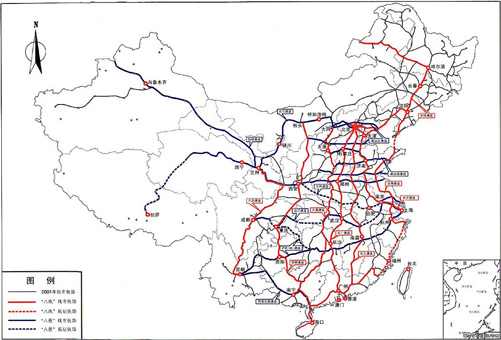(单词翻译:单击)
正文文本
The latest figures from the statistics bureau show that China had 130-thousand kilometers of operating railway by the end of last year. To put that in context, the country's rail network is now 5-times longer than it was back when the People's Republic of China was founded in 1949.
China is also home to the world's largest high-speed railway network, which had more than 30-thousand kilometers of track in service at the end of last year. In terms of roads, China now has a network that stretches for 4.9 million kilometers, a 59-fold increase from 1949. This includes 140-thousand kilometers of expressway, the world's largest network of its kind.
Since the 18th National Congress of the Communist Party of China, the central government repaired 1.3 million kilometers of road over a five-year period. But the most dramatic change has taken place in air travel, with the total length of scheduled flights reaching 8.4 million kilometers, 734 times higher than the distance traveled by air in 1950.
Hu Siji, a professor with Beijing Jiaotong University, is in his 80s. He has witnessed the changes to the country's transportation over the past 70 years, and said that investment in transportation infrastructure has helped to boost China's economic growth.
"First of all, transportation is all about infrastructure construction, which requires heavy investment. As a result, it can fuel the country's construction investment. Second, before the reform and opening up, the development of the road network had been advancing unevenly. Now, the country is promoting the rational layout of road networks in a bid to make the development of the national social economy more balanced."

The deputy transport minister, Liu Xiaoming, said China has become a transportation power.
"Since the reform and opening up, the pace of infrastructure construction has been accelerating, and it has successfully achieved a major leap from "bottleneck restriction" to "preliminary mitigation" to "basic adaptation", to now reach economic and social development. And now, the whole sector is well and truly on a special path with Chinese characteristics."
Liu Xiaoming believes that innovation is the key to a strong transportation sector.
"Innovation helps to upgrade the transportation sector, from being one that is big to being one that is strong. We will put it in a key position for overall development, and we will support and lead the construction of a powerful transportation country."
The boom in the construction of the country's transportation networks has helped them to keep up with growing demand.
Looking at the demand on the rail network, for example, back in 1978, at the start of China's reform and opening up, 1 billion tons of freight were carried by rail. That figure has now reached 4 billion tons a year.
And the number of trips taken by passengers has also boomed over the past four decades, from 815 million to 3.4 billion trips a year.
For CRI, this is Wen Jie.
参考译文
中国国家统计局日前发布的数据显示,2018年末,中国铁路营业里程达到13.1万公里。在此让大家了解一下背景,中国铁路营业里程比1949年新中国成立时增长了5倍。
中国也拥有世界上最大的高速铁路网,去年年末,高速铁路的营业里程已超过3万公里。公路方面,中国公路网络达到490万公里,比1949年增长了59倍。其中高速公路总里程超过14万公里,居世界第一。
自中共十八大以来,中央政府在五年内修复了130万公里的道路。但是最显著的变化发生在航空业,定期航班航线里程840万公里,比1950年末增长734倍。
胡思继是北京交通大学的教授,他今年已经80多岁。他亲历了新中国70年交通事业的变迁,他说,交通基础设施的投资与建设,已经成为中国经济稳定增长的助推器。
“首先,交通事业是基础设施建设,需要大量投资,这就会启动我们国家的建设投资。第二,改革开放前,路网的建设很不均衡。国家(如今正在)进一步促进我们(交通)的合理布局,通过合理布局来促进国家社会经济的均衡发展。”
中国交通运输部副部长刘小明表示,中国已经建成交通大国。
“改革开放以来,基础设施建设步伐加快,中国交通运输实现了从瓶颈制约,到总体缓解,再到基本适应的重大跃升,实现了经济社会的发展。现在,交通运输走出了一条具有中国特色的交通运输发展道路。”
刘晓明认为,创新是交通运输强大的关键。
“创新有助于提升交通运输产业,实现交通运输从大到强的历史性转变,关键要靠创新。我们将把创新摆在全局发展的核心位置,以创新支撑和引领交通强国建设。”
中国交通网络建设的蓬勃发展有助于满足不断增长的需求。
看看1978年铁路网的需求,在中国改革开放之初,铁路货物发送量10亿吨。而现在每年的货物发送量已达到40亿吨。
在过去四十年中,乘客的出行次数也在蓬勃发展,从每年8.15亿人次增加到34亿人次。
CRI新闻,文杰(音译)报道。
重点讲解
重点讲解:
1. in service (车辆、设备)在使用中,可以使用;
Also, a train strike had been paralyzing traffic for about a week, with only few trains in service here and there.
而且,火车员工的罢工也导致交通瘫痪一周,只有很少几辆运行。
2. in terms of 在…方面;从…角度看;根据…来说;
In terms of regional competition the attraction and competitiveness of a city are inseparable from its cultural background.
区域竞争中,城市吸引力和竞争力的提高离不开其文化底蕴的提升。
3. as a result 结果;后果;
As a result, the bad thing has been turned into a good one.
结果坏事变成了好事。
4. keep up with 跟上(变化等);
We must keep up with the times.
我们必须跟上时代前进的步伐。


